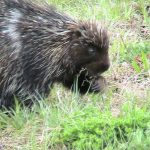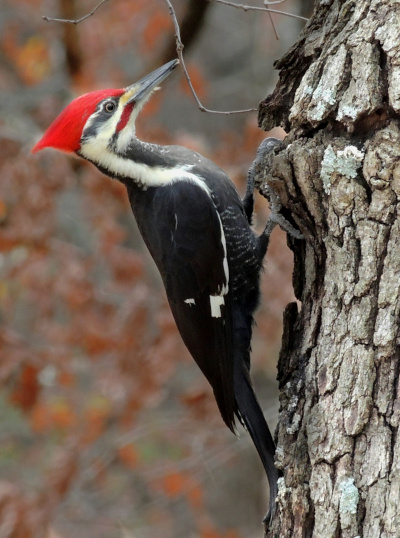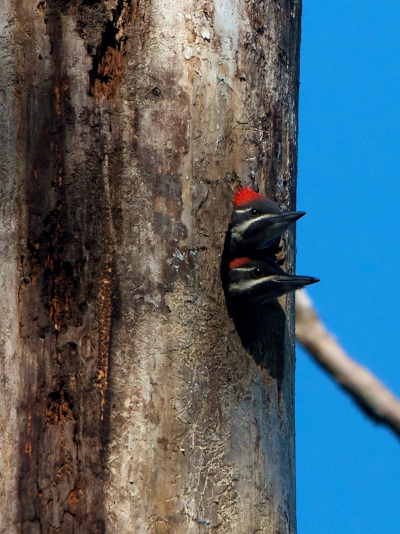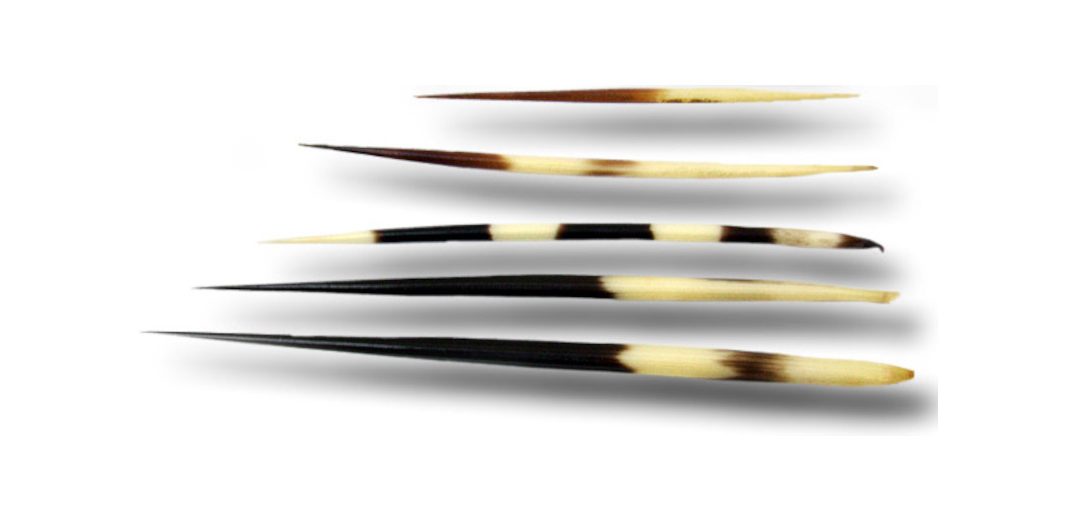Porcupine Quills in Various Lengths. Imagine them entirely transluscent without color.
 Quills. Usually I associate a quill with a porcupine. Their quills are actually hair. Long, thick, hard and sharp. Popular belief in years past was that a porcupine could flick his tail at you and fill the air with missiles that would puncture your skin and leave you hurting. The myth was untrue as porcupines cannot “throw” their quills. If they swat you or any other critter with their tail, the quills will easily puncture the skin, grab on with their barbs and indeed, a painful removal experience awaits those foolish enough to allow themselves to be swatted.
Quills. Usually I associate a quill with a porcupine. Their quills are actually hair. Long, thick, hard and sharp. Popular belief in years past was that a porcupine could flick his tail at you and fill the air with missiles that would puncture your skin and leave you hurting. The myth was untrue as porcupines cannot “throw” their quills. If they swat you or any other critter with their tail, the quills will easily puncture the skin, grab on with their barbs and indeed, a painful removal experience awaits those foolish enough to allow themselves to be swatted.
A friend once came knocking in the early morning. Actually, he didn’t knock, just came right on in. Don’t freak out, that was Small Town America in the 1970s and 80s, and even the 90s, where neighbors and friends might just walk right in, if they feel comfortable at your home.
 The reason for his visit was a tiny critter he held in the palm of one hand. It was white, had pink eyes, and a multitude of quills–a baby, albino porcupine just a few days old. How cute. How interesting. And… you could hold it carefully and pet it as long as you stroked in the direction of the quills. If you didn’t you got stuck. Ouch. The baby’s quills were not actually white, but translucent.
The reason for his visit was a tiny critter he held in the palm of one hand. It was white, had pink eyes, and a multitude of quills–a baby, albino porcupine just a few days old. How cute. How interesting. And… you could hold it carefully and pet it as long as you stroked in the direction of the quills. If you didn’t you got stuck. Ouch. The baby’s quills were not actually white, but translucent.
Its mother was hit by a car and the cute little porky was motherless. As a side note, for a long time I wondered how mama porcupines gave birth without getting skewered. Turns out, the quills are soft and flexible before birth and stay that way for a short while afterward. This baby’s quills were hard, so probably it was a few days old.
However, that doesn’t answer the question of how adult porcupines make baby porcupines without skewering each other. We won’t explore that topic today.
Porcupines are solitary critters. They like to bumble along, looking for tasty stuff to eat. They never hurry, just mosey along. In the summer, they eat grass and clover and other yummy green plants. In the winter, their diet changes to the soft bark of a tree up near the top. They climb very well and will nestle in for days in the top of a prime tree, eating the bark all the way around the trunk and sometimes in a swath three to six feet tall.
Unfortunately for the tree, this is usually means the top will die. It also invites the infestation of insects that like to eat trees, and thus, the remaining tree may die as well.
However, this is not necessarily bad in the grand scheme of things. The bugs that burrow into the tree are tasty treats for woodpeckers. In fact, the piliated woodpecker (think Woody Woodpecker without the attitude) will bore large holes into these trees looking for insects to eat. In the process, they hollow out large portions of the trunk.
In the spring, a pileated woodpecker will make bigger holes to build their nests and raise a brood of woodpeckers that will benefit from the chewing of a porcupine. Once abandoned by the woodpeckers, the nesting holes are sometimes used in subsequent years by wood ducks. To see one flying at full speed and appear to literally crash into the tree is amazing. If you blink, you miss it and wonder where the duck went. Then the head emerges and it looks around for a moment before hiding again.

Our friend had some coffee with us and probably one or two of Mom’s homemade rolls, and took the baby porcupine home. A farmer supplied raw whole milk for it, and the baby grew. As it grew, it did what porcupines do best, and that is chew things. They love anything that has been in contact with salt and will eat entire ax handles because of the sweaty salt in them. Baby Porky wasn’t such a baby anymore, and it wasn’t much of a pet either. In fact, our friend never intended to keep it as a pet. Once it was weaned off the milk, it had to forage for grass and clover in the yard, just alike any other porky.
One day our friend put on his heavy leather gloves and loaded Porky into a bucket (Porky was used to short trips in the bucket by then.) He put the bucket into his backpack and drove to a remote area, then hiked about three miles into the woods. The last time our friend saw Porky, he had climbed into a willow bush and was happily munching on the bark, doing what porcupines do best.
Copyright © 2013 MJ Logan Writer All Rights Reserved
No republication without expressly written consent.

